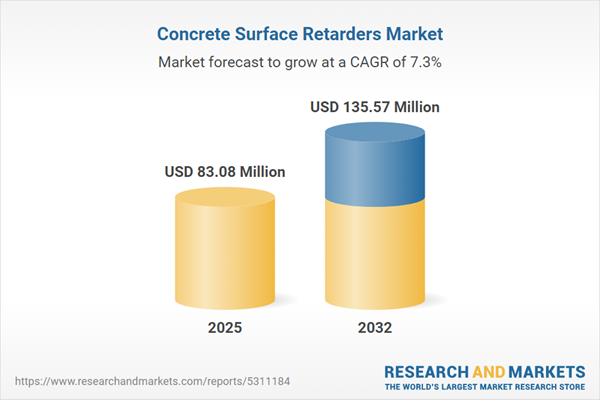Speak directly to the analyst to clarify any post sales queries you may have.
The concrete surface retarders market is transforming as regulatory pressures, sustainability targets, and digital advancements reshape construction priorities. Senior decision-makers must navigate these developments to capitalize on efficiency, compliance, and evolving client expectations.
Market Snapshot: Concrete Surface Retarders Market Size and Forecast
The concrete surface retarders market grew from USD 77.40 million in 2024 to USD 83.08 million in 2025. It is expected to expand at a CAGR of 7.25%, reaching USD 135.57 million by 2032. These figures underscore the market’s resilience and growth potential, even amidst regulatory and supply chain complexities.
Scope & Segmentation: Comprehensive Market Coverage
Product Types and Forms
- Acid-Based: Includes phosphoric acid and sulfamic acid variants supporting a range of surface exposure requirements.
- Biodegradable: Enzyme-based and plant-derived formulations responding to sustainability demands.
- Caustic-Based: Uses compounds such as potassium hydroxide or sodium hydroxide to achieve reliable set control.
- Polymer-Based: Acrylic and latex polymer solutions for high-performance and specialty finishes.
- Form Options: Liquid systems enabling fast, uniform application and powder forms offering storage advantages for remote or long-term use.
Applications
- On Site: For facades, floors, and sidewalks where adaptability to weather variation is critical.
- Pre Cast: Includes blocks, hollow core, and wall panels to maintain quality and consistency across batches.
- Repair: Targeted at crack repair and restoration, supporting durability and appearance in refurbishment projects.
End User Industries
- Commercial: Hospitality, office buildings, and retail developments driving demand for decorative and functional surface finishes.
- Industrial: Applications in manufacturing plants, power generation, and warehouses requiring durable treatments.
- Infrastructure: Coverage for bridges, roads, and tunnels supporting safety, longevity, and regulatory compliance.
- Residential: Growing emphasis on aesthetic value in housing projects and urban developments.
Regional Coverage
- Americas: North America (United States, Canada, Mexico) and Latin America (Brazil, Argentina, Chile, Colombia, Peru).
- Europe, Middle East & Africa: Markets including the United Kingdom, Germany, France, Russia, Italy, Spain, Netherlands, Sweden, Poland, Switzerland, UAE, Saudi Arabia, Qatar, Turkey, Israel, South Africa, Nigeria, Egypt, Kenya.
- Asia-Pacific: China, India, Japan, Australia, South Korea, Indonesia, Thailand, Malaysia, Singapore, Taiwan.
Key Takeaways for Senior Decision-Makers
- Sustainability mandates are steering producers toward biodegradable and less hazardous formulations, aligning with global green-building criteria.
- Digital technologies in application methods allow precise dosage control and set-time monitoring, increasing efficiency and finish quality in diverse projects.
- Collaborations between chemical suppliers and construction tech firms are ushering in integrated, smart solutions that address operational and regulatory expectations.
- Segmented product development enables manufacturers to meet varying end-user needs across commercial, infrastructure, and residential construction with targeted solutions.
- Market competitiveness hinges on third-party environmental certifications and adherence to the latest safety and sustainability standards.
- Regional trends, such as rapid urbanization in Asia-Pacific and stringent policy frameworks in Europe, offer distinct opportunities for tailored innovation.
Tariff Impact on Supply Chains
Recent United States tariffs have raised input costs, prompting manufacturers to adjust sourcing strategies and invest in domestic or nearshore production. Suppliers and contractors are now focusing on supply chain resilience, cost management, and long-term partnership negotiation to minimize project disruptions and maintain delivery timelines.
Methodology & Data Sources
This report is based on in-depth interviews with stakeholders, comprehensive secondary research—including technical publications and construction data—and validation through expert panels. Both bottom-up shipment analyses and macroeconomic assessments ensure robust, actionable intelligence for strategic planning.
Why This Report Matters
- Supports executive decision-making with a clear understanding of evolving product, technology, and supply chain trends in concrete surface retarders.
- Enables targeted growth strategies by highlighting regional performance drivers and segment-specific adoption patterns.
- Reinforces compliance and innovation by detailing competitor actions, regulatory frameworks, and environmental best practices.
Conclusion
Stakeholders equipped with timely intelligence on sustainability initiatives, technological integration, and supply chain adjustments will be best positioned to achieve long-term competitive strength in the concrete surface retarders market. Proactive adaptation will ensure success despite continued market changes.
Additional Product Information:
- Purchase of this report includes 1 year online access with quarterly updates.
- This report can be updated on request. Please contact our Customer Experience team using the Ask a Question widget on our website.
Table of Contents
3. Executive Summary
4. Market Overview
7. Cumulative Impact of Artificial Intelligence 2025
Companies Mentioned
The companies profiled in this Concrete Surface Retarders market report include:- Sika AG
- BASF SE
- MBCC Group GmbH
- W. R. Grace & Co.
- Fosroc International Ltd.
- Mapei S.p.A.
- RPM International Inc.
- Chryso SAS
- Pidilite Industries Limited
- CICO Technologies Limited
Table Information
| Report Attribute | Details |
|---|---|
| No. of Pages | 181 |
| Published | October 2025 |
| Forecast Period | 2025 - 2032 |
| Estimated Market Value ( USD | $ 83.08 Million |
| Forecasted Market Value ( USD | $ 135.57 Million |
| Compound Annual Growth Rate | 7.2% |
| Regions Covered | Global |
| No. of Companies Mentioned | 11 |









